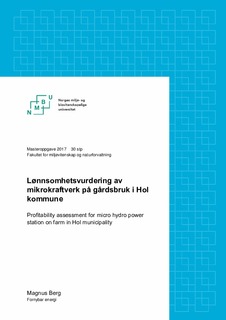| dc.contributor.advisor | Sønju-Moltzau, Bjørn | |
| dc.contributor.author | Berg, Magnus | |
| dc.coverage.spatial | Norway, Hol | nb_NO |
| dc.date.accessioned | 2018-09-27T12:09:48Z | |
| dc.date.available | 2018-09-27T12:09:48Z | |
| dc.date.issued | 2017 | |
| dc.identifier.uri | http://hdl.handle.net/11250/2565002 | |
| dc.description.abstract | I denne masteroppgaven vurderes lønnsomheten ved å bygge et mikrovannkraftverk i en bekk ved gården til Jan Borgnes som ligger i Hol kommune. To hovedalternativer undersøkes hvor forskjellen er høydeplassering av turbin og antall naboer som er med på prosjektet. Alternativ 1 har lavest fallhøyde og gir minst produksjon, men har også lavere investeringskostnader. Det er gjort fem vannføringsmålinger i bekken høsten 2016 og vinteren 2017 i tillegg til beregning av vannføring gjennom året med måledata fra to nærliggende målestasjoner og dataprogrammet DAGUT som Norges vassdrags- og energidirektorat (NVE) disponerer. Disse målingene er satt sammen til en historisk vannføringsserie for 40 år og brukt i produksjonssimuleringen i DAGUT. Inntekten fra kraftverket beregnes som spart strømforbruk i boligene til Jan og naboen(e) ved utnyttelse av egenprodusert strøm, og inntekt ved salg av strøm på strømnettet. Kostnader er hentet inn fra NVEs «Veileder i planlegging, bygging og drift av små kraftverk» og leverandører og entreprenører i området. | nb_NO |
| dc.description.abstract | In this master thesis, the profitability of building a micro hydro power station in a stream is considered. The stream is situated by the farm of Jan Borgnes in the municipal of Hol. Two main alternatives are examined, where the differences are placement of the turbine in the terrain and the number of neighbors included in the project. Alternative 1 has the lowest head of water and gives the lowest production, but also has the lowest investment costs. Five measurements on the rate of flow in the stream has been made in the autumn of 2016 and winter of 2017, as well as estimations of the rate of flow throughout the year with measurements from two metering stations in the nearby area and the computer program DAGUT which is used by The Norwegian Water Resources and Energy Directorate (NVE). These measurements are put together to form a historical flow series for 40 years and used in the production simulation in DAGUT. The revenues from the power station are calculated as saved electricity consumption in the houses of Jan and the neighbor(s) by using produced power, as well as income from selling power to the grid. Costs are obtained from NVE’s “Guide for planning, building and running of small hydro power stations” and suppliers and contractors in the nearby area. | nb_NO |
| dc.language.iso | nob | nb_NO |
| dc.publisher | Norwegian University of Life Sciences, Ås | nb_NO |
| dc.rights | Attribution-NonCommercial-NoDerivatives 4.0 Internasjonal | * |
| dc.rights.uri | http://creativecommons.org/licenses/by-nc-nd/4.0/deed.no | * |
| dc.subject | Mikrokraft | nb_NO |
| dc.subject | Vannkraft | nb_NO |
| dc.subject | Lønnsomhet | nb_NO |
| dc.title | Lønnsomhetsvurdering av mikrokraftverk på gårdsbruk i Hol kommune | nb_NO |
| dc.title.alternative | Profitability assessment for micro hydro power station on farm in Hol municipality | nb_NO |
| dc.type | Master thesis | nb_NO |
| dc.description.version | submittedVersion | nb_NO |
| dc.source.pagenumber | 56 | nb_NO |
| dc.description.localcode | M-FORNY | nb_NO |

